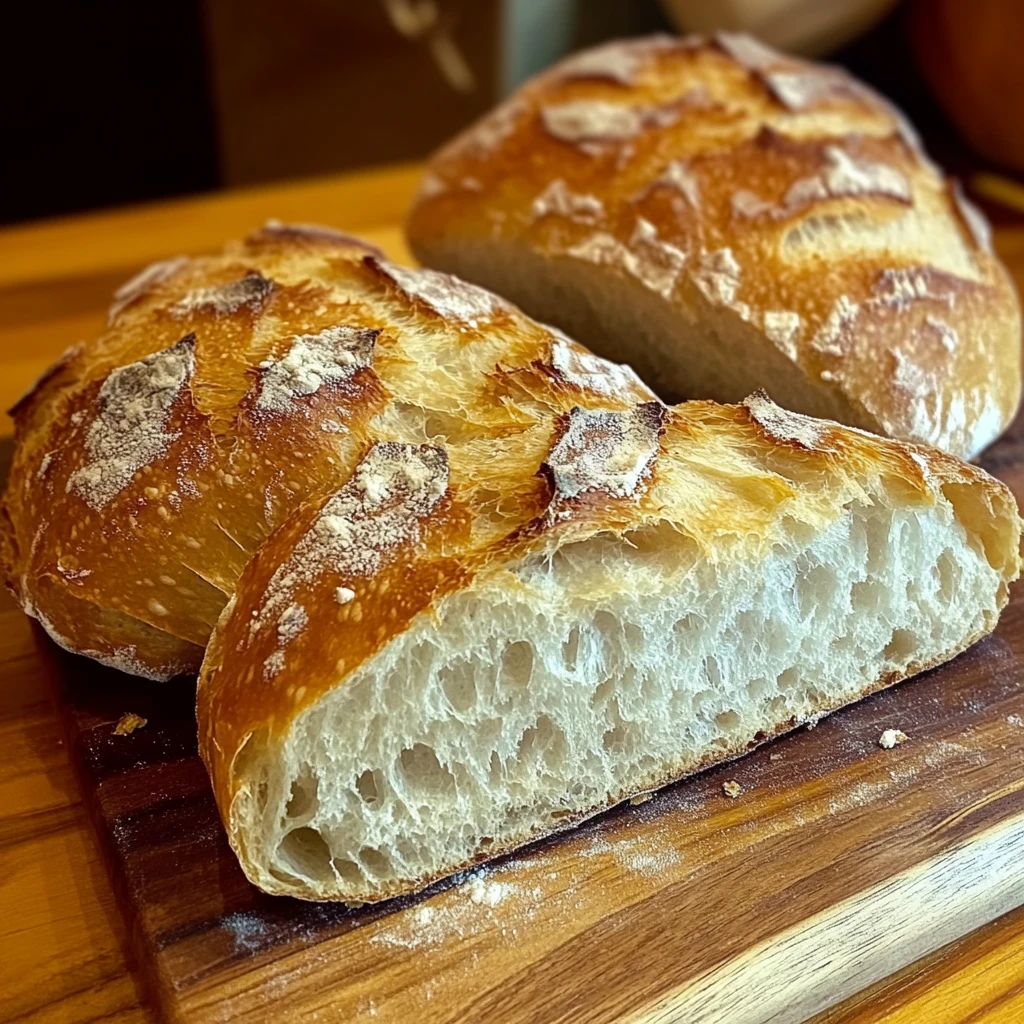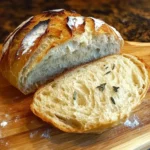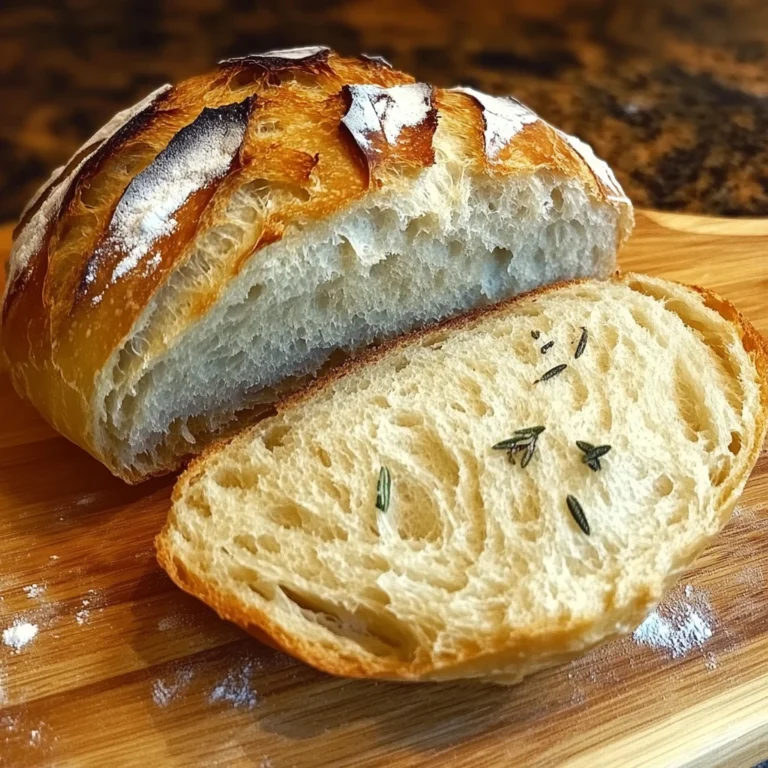Crusty Italian bread has long been a beloved staple in the world of carb-loving cuisine. With its golden-brown exterior, chewy crumb, and undeniable aroma, this classic loaf has the power to transport you to the heart of an Italian bakery. Whether you’re dunking it in olive oil and balsamic, using it as the foundation for a hearty sandwich, or simply savoring it fresh from the oven, Crusty Italian Bread is a true culinary delight.
Table of Contents
Mastering the Ingredients for Crusty Italian Bread
The secret to making an authentic Crusty Italian Bread lies in the simplicity of its ingredients. At its core, this beloved loaf requires just a handful of pantry staples:
- 3½ cups all-purpose flour – The foundation that provides structure and texture to the bread.
- 1½ teaspoons salt – Enhances the overall flavor and controls the yeast fermentation.
- 1 tablespoon granulated sugar – Feeds the yeast, helping to activate and sustain the rising process.
- 1¼ cups warm water (110°F) – The perfect temperature to activate the yeast and hydrate the dough.
- 2¼ teaspoons active dry yeast – The leavening agent responsible for creating the light, airy crumb.
- Cornmeal (for dusting) – Adds a delightful crunch and helps prevent the dough from sticking.
While the ingredient list may seem straightforward, each component plays a vital role in creating the perfect Crusty Italian Bread. The flour provides the structure, the salt enhances the flavor, the sugar feeds the yeast, the warm water activates the rising process, and the cornmeal adds a delightful textural contrast.
Step-by-Step Instructions for Baking Crusty Italian Bread
Activate the Yeast
Begin by combining the warm water, sugar, and yeast in a large mixing bowl. Gently stir the mixture and allow it to sit for 5-10 minutes, until it becomes frothy and bubbly. This crucial step ensures the yeast is active and ready to work its magic.
Mix the Dough
Once the yeast mixture is ready, add the flour and salt to the bowl. Using a wooden spoon, stir the ingredients together until a rough dough begins to form. This initial mixing helps develop the gluten structure that will give the bread its signature chewiness.
Knead the Dough
Turn the dough out onto a lightly floured surface and knead it for 8-10 minutes, until it becomes smooth and elastic. This hands-on kneading process is vital for building the gluten network and creating the perfect crumb texture.
First Rise
Place the kneaded dough in a lightly greased bowl, cover it with a damp cloth, and let it rise in a warm spot for 1-1½ hours, or until it has doubled in size. This initial rise allows the yeast to work its magic, producing the essential gases that will give the bread its light and airy structure.
Shape the Dough
Punch down the risen dough to release any excess air bubbles, then shape it into a round or oval loaf. Place the shaped dough on a baking sheet dusted with cornmeal, which will help create a delightfully crunchy crust.
Second Rise
Cover the shaped dough with a clean cloth and let it rise for an additional 30-45 minutes. This second rise helps the bread develop its signature shape and prepares it for the baking process.
Preheat the Oven
While the dough is rising, preheat your oven to 450°F (232°C). Place a shallow pan of water on the bottom rack to create steam, which will aid in the development of the crust.
Bake the Bread
Just before baking, use a sharp knife to make a few slashes across the top of the loaf. This allows the bread to expand during the initial baking stage. Bake the bread for 25-30 minutes, or until the crust is a deep golden-brown and the loaf sounds hollow when tapped.
Cool and Enjoy
Remove the freshly baked Crusty Italian Bread from the oven and let it cool completely on a wire rack before slicing and serving. This cooling process allows the crumb to set and the crust to reach its full crispness.

Tips for Perfecting Your Crusty Italian Bread
Avoid Over-Kneading
While kneading is crucial for developing the gluten, over-kneading can lead to a dense, tough texture. Pay attention to the dough’s smoothness and elasticity as a guide, and don’t be tempted to knead for too long.
Ensure Proper Yeast Activation
Properly activating the yeast is key to achieving the perfect rise. Make sure your water is within the optimal temperature range, and give the yeast enough time to become frothy and bubbly before proceeding with the recipe.
Utilize a Baking Stone
For an even crispier crust, consider baking your Crusty Italian Bread on a preheated baking stone or steel. The dense, heat-retaining surface will help create a crisp, bakery-style exterior.
Serving Suggestions and Pairings
The beauty of Crusty Italian Bread lies in its versatility. Enjoy it simply with a drizzle of high-quality olive oil and a sprinkle of sea salt, or use it as the foundation for a hearty Italian sandwich. It also pairs beautifully with soups, stews, and pasta dishes, adding a satisfying textural contrast to the meal.
For a truly indulgent experience, consider transforming any leftover Crusty Italian Bread into garlicky bruschetta, crispy croutons, or a delectable panini filled with your favorite ingredients.
More Related Recipes You Might Enjoy
FAQs about Crusty Italian Bread
How can I achieve a thicker crust on my Crusty Italian Bread?
To achieve a thicker crust on your Crusty Italian Bread, you can employ a few techniques. First, ensure your oven is adequately preheated to a high temperature, ideally around 450°F (232°C). Additionally, creating steam in the oven during the first few minutes of baking helps develop a thicker crust. You can do this by placing a shallow pan filled with water on the bottom rack of the oven or by misting water into the oven with a spray bottle just after you put the bread in. Lastly, consider using a baking stone or a Dutch oven, as these retain heat well and promote a crispy crust.
What type of flour is best for making Crusty Italian Bread?
While all-purpose flour is commonly used for Crusty Italian Bread, bread flour is often recommended for a superior texture. Bread flour has a higher protein content, which leads to better gluten development, resulting in a chewier and more structured loaf. If you prefer a more rustic flavor, you could also mix in some whole wheat flour or use Italian “00” flour, which is finely milled and traditionally used for Italian breads. Adjusting the hydration level in your recipe may be necessary when using different types of flour.
Can I add herbs or spices to my Crusty Italian Bread dough?
Yes, you can certainly add herbs, spices, or other flavorings to your Crusty Italian Bread dough to enhance its taste. Common additions include dried oregano, rosemary, or garlic powder. It’s best to add these ingredients during the mixing stage, ensuring they are evenly distributed throughout the dough. If using fresh herbs, chop them finely and add them after the initial mixing to avoid disrupting the gluten development. Keep in mind that adding too many ingredients may affect the dough’s hydration, so adjust your liquid accordingly.
How do I know when my Crusty Italian Bread is fully baked?
To determine if your Crusty Italian Bread is fully baked, there are a few methods you can use. First, look for a deep golden-brown crust and a hollow sound when you tap the bottom of the loaf. Additionally, you can use an instant-read thermometer; the internal temperature should register around 190°F to 210°F (88°C to 99°C). If you prefer a softer interior, aim closer to 190°F, while a higher temperature will yield a drier crumb. Lastly, allow the bread to cool completely before slicing to ensure the crumb sets properly.
Mastering the art of Crusty Italian Bread is a rewarding journey that brings the flavors of Italy right to your kitchen. With a little patience, the right techniques, and a passion for homemade bread, you’ll be enjoying the irresistible aroma and satisfying texture of this beloved loaf in no time. So preheat your oven, gather your ingredients, and get ready to bake up a slice of Italian heaven!
Craving even more magical meals? Browse Amelia’s Pinterest boards for quick dinners, cozy bakes, and tons of flavorful inspiration.
Print
Master the Art of Crusty Italian Bread in Just 5 Steps!
- Total Time: 2 hours
- Yield: 1 loaf 1x
- Diet: Vegetarian
Description
Unlocking the Secret to Irresistible Crusty Italian Bread
Ingredients
- 3 1/2 cup all-purpose flour
- 1 1/2 teaspoon salt
- 1 tablespoon granulated sugar
- 1 1/4 cup warm water (110°F)
- 2 1/4 teaspoon active dry yeast
- Cornmeal (for dusting)
Instructions
1. Begin by combining the warm water, sugar, and yeast in a large mixing bowl. Gently stir the mixture and allow it to sit for 5-10 minutes, until it becomes frothy and bubbly.
2. Once the yeast mixture is ready, add the flour and salt to the bowl. Using a wooden spoon, stir the ingredients together until a rough dough begins to form.
3. Turn the dough out onto a lightly floured surface and knead it for 8-10 minutes, until it becomes smooth and elastic.
4. Place the kneaded dough in a lightly greased bowl, cover it with a damp cloth, and let it rise in a warm spot for 1-1 1/2 hours, or until it has doubled in size.
5. Punch down the risen dough to release any excess air bubbles, then shape it into a round or oval loaf. Place the shaped dough on a baking sheet dusted with cornmeal.
6. Cover the shaped dough with a clean cloth and let it rise for an additional 30-45 minutes.
7. While the dough is rising, preheat your oven to 450°F. Place a shallow pan of water on the bottom rack to create steam.
8. Just before baking, use a sharp knife to make a few slashes across the top of the loaf. Bake the bread for 25-30 minutes, or until the crust is a deep golden-brown and the loaf sounds hollow when tapped.
9. Remove the freshly baked Crusty Italian Bread from the oven and let it cool completely on a wire rack before slicing and serving.
Notes
Avoid over-kneading to prevent a dense texture.
Ensure proper yeast activation for the best rise.
Consider using a baking stone for a crispier crust.
- Prep Time: 20 minutes
- Cook Time: 30 minutes
- Category: Bread
- Method: Baking
- Cuisine: Italian
Nutrition
- Serving Size: 1 slice
- Calories: 120
- Sugar: 0g
- Sodium: 300mg
- Fat: 1g
- Saturated Fat: 0g
- Unsaturated Fat: 0g
- Trans Fat: 0g
- Carbohydrates: 24g
- Fiber: 1g
- Protein: 4g
- Cholesterol: 0mg

